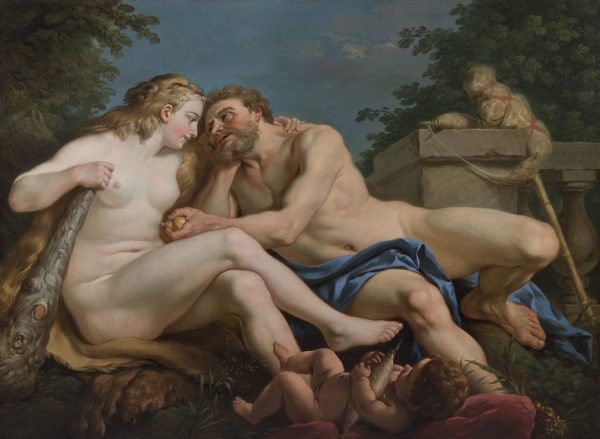Hercules and Omphale, 1776
Oil on canvas, H. 0.98 m; W. 1.34 m
Signed and dated on the balustrade on the right: L. Lagrenée 1776.
Provenance: Private collection.
- Catalogue of the Salon of 1781, Paris, p. 13, no. 8.
- Marc Sandoz, Les Lagrenée I. Louis (Jean François) Lagrenée 1725-1805, Paris, 1983, p. 251, no. 298.
A pupil of Carle van Loo, Lagrenée won the Rome Prize in 1749. He spent four years in Italy where he copied the great masters and concentrated on developing his technique. On his return to Paris in 1753 he painted Deianeira Abducted by the Centaur Nessus (Paris, Musée du Louvre), which enjoyed great success. From 1755, he participated regularly in the Salon. In 1760 the Empress Elizabeth invited him to St. Petersburg where he was appointed director of the Academy of Fine Arts. He left for Russia with his brother and pupil Jean Jacques called the Younger, but following the empress’s death in 1762 they returned to France. Back in Paris, he became professor at the Académie and between 1781 and 1787 he held the position of Director of the French Academy in Rome.
An implicated and conscientious artist, Lagrenée created a large number of ancient and mythological scenes, religious paintings and history scenes. His colouring is bright and pleasant and his compositions are skilful, but without rigour. More traditionalist than innovative, Lagrenée is the great artisan of a genre, amiable mythological painting, which ensured France’s major influence in Europe during the second half of the 18th century.
The loves of Hercules and Omphale, a myth of the submission of an especially virile hero to the whims of a woman as atonement for a crime, is known with many variations. Hercules, son of Zeus is beguiled by the Queen of Lydia, Omphale. Known for his physical strength, the hero is reduced to feminine tasks such as spinning. The oracle of Apollo had advised Hercules, who was trying to atone for the murder of one of his friends, to serve the queen. Seduced by his strength and beauty, the queen Omphale marries Hercules.
Hercules and Omphale are shown in a park indicated only by some vegetation and a balustrade on the right on which a distaff rests. A putto lies at their feet on a red velvet cushion with a golden tassel and holds a spindle in his arms. Omphale is sitting naked on the skin of the Nemean lion, holding the club in her right hand. She enfolds Hercules by the neck with her left hand. The hero, naked on a blue drapery is leaning towards her, supported on his elbow.

